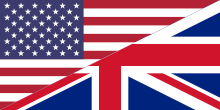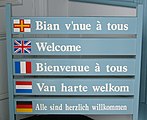Flag icons for languages

The use of flag icons, particularly
national flags, for languages is a common practice. Such icons have long been used on tourist attraction signage, and elsewhere in the tourism space, but have found wider use in website localization where UX limitations have become apparent.[1][2]
Mixed flags




Sometimes the flags of international linguistic communities, such as the flag of the
Community of Portuguese Speaking Countries or the flag of the Commonwealth of Nations, may be used, but they are not as widely recognized as national flags.[3] When more than one country is a major user of a language, a diagonally divided flag may be used. Examples of this are the flags of the United Kingdom, the United States and Canada to indicate the English language, or the flags of China and Taiwan (Republic of China) to represent the Chinese language (Mandarin), or the flags of France, Belgium, and Canada to represent the French language, or the flags of Spain and Mexico to represent the Spanish language, or the flags of Portugal and Brazil to represent the Portuguese language.[4][5]
Writing systems
Where two written standards exist for a single language, national flags can be used to distinguish between them: for example, the
Simplified Chinese.[6]
 |
 |
|---|---|
 |
 |
Political motivations
Irish flag for both English and Irish
Some
Anglophone nations left in the European Union (another being Malta). Dr. Oetker have been observed doing the same.[7] The Irish flag is more usually used to signify the Irish language.[8]
Criticism
The use of flag icons for languages has been criticized as poor design.[9] The symbolism of a national flag introduces politicization, and often ambiguity.
Belying the nation-state concept, many languages are natively spoken in several countries, and many countries have several major languages. Alternatives include using the native names of languages or their language codes, possibly under a generic symbol of translation such as the Language Icon.
Gallery
-
Sign in San Francisco, Córdoba, Argentina; unusually, the Spanish language is indicated by an Argentine flag, while below it is Italian and Piedmontese text with the flags of Italy and Flag of Piedmont.
-
Sign in Ireland in 9 languages, with flags and country names for each.
-
Sign in Ireland in 8 languages, including Romanian, Japanese and Simplified Chinese, with flags for each.
-
Sign in Ireland in 8 languages.
See also
References
- ISBN 9780132603645– via Google Books.
- ISBN 9781573872096– via Google Books.
- ^ Heritage, Canadian (August 15, 2017). "Flags of La Francophonie". www.canada.ca.
- ^ Grainger, Jonathan (July 20, 2017). On national flags and language tags: Effects of flag-language congruency in bilingual word recognition. Acta Psychologica – via Science Direct.
- ISBN 9781351184632– via Google Books.
- ISBN 9780244800529– via Google Books.
- ^ Troughton-Smith, Steve (14 April 2019). "English instructions on the back of EU food coming with an Irish flag 🇮🇪 instead of a UK one 🇬🇧 is my new favorite burn 🤣". Twitter.
- ^ McNally, Frank. "English Stew – Frank McNally on a meeting of the anglophone world in Limerick". The Irish Times.
- ISBN 978-0-596-52030-4.
External links
Wikimedia Commons has media related to Flags indicating languages.
- Flags are not languages (blog)






